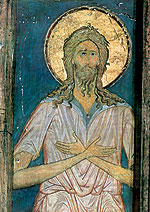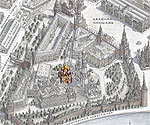 |
|
The Moscow Kremlin. The Cathedral of the Dormition. 1480-1481
The new stone Cathedral of the Dormition in Moscow was erected by an Italian master Aristotle Fioravanti in 1475-1479. It was regarded as the principal Orthodox cathedral, the most important public edifice, the church of the Sovereign of “all Rus”, the Grand Prince of Moscow Ivan III.
From this time on, church councils were held in the cathedral that symbolized the grandeur of a new European state: Russian metropolitans were elected, bishops were appointed, and the Russian tsars were crowned. The icons of the Dormition Cathedral were venerated as sacred and served as a model for new ones.
Dionisy was first mentioned in chronicles in relation to his work in the cathedral in 1481: “The same year the Bishop of Rostov Vassian gave one hundred rubles to the icon master Denisy and pope Timothy and Yarets and Kon for painting the Deesis in the new church of the Mother of God which was wonderfully done together with the Feasts and Prophets”.
 St. Metropolitan Peter with scenes from his life. Dionisy and his studio |
A team of craftsmen (artel) headed by the most skillful icon painter were assigned to produce the new iconostasis for the cathedral-symbol. Most likely, the Deesis on the stone side-altar walls of the Dormition Cathedral that the cathedral inventory of the 17th century refers to was painted at that time. Neither the iconostasis nor the altar Deesis have survived. The compositions of the lower tier on the altar walls in the Sts. Peter and Paul and Praise Side-chapels are attributed to the same period and artistic circle. The Praise Side-chapel retains the upper part of the scenes dedicated to the Theotokos, the Adoration of the Magi. This multi-figure composition is skillfully inscribed in the round arch. Dionisy, being a brilliant graphic artist and colourist, creates a festive though subtle colour range for this fresco. The southern wall has preserved the upper part of the Nativity of John the Baptist fresco. On the southern wall of the Sts. Peter and Paul Side-chapel there are two scenes of the time: St. Peter, Healer of Diseases and Forty Holy Martyrs of Sebaste, out of which only twenty four figures remained.
 St. Metropolitan Alexius with scenes from his life. Dionisy and his studio |
The space between the Deesis and Sovereign tiers is filled with half-length figures of saints that were esteemed in Russia. This technique of covering a blank altar wall with images had been tried before, in the first third of the fifteenth century, in the Church of the Assumption on Gorodok and the cathedral of the St. Savva Storozhevsky Monastery in Zvenigorod.
In the 1480s, Dionisy painted a pair of icons of the Moscow Metropolitans Peter and Alexius with scenes from their lives for the new cathedral.
These are the first icons of the miracle workers with scenes from their lives. They were carefully designed as they were to play a key role in the decoration of the new cathedral in 1513-1515 while its walls were still being painted.
At present, the icon Metropolitan Peter with Scenes from His Life is displayed in the Dormition Cathedral of the Moscow Kremlin it was intended for, whereas the other of Metropolitan Alexius is exhibited in the Tretyakov Gallery.
Experts know of around ten cathedrals whose walls were painted by Dionisy. Some of the painter’s works are lost for good; some have been preserved by restorers
Only the wall painting of the Virgin Nativity Cathedral of the St. Ferapont Belozero Monastery has survived in full and intact |
|
According to historical documents, the following works of Dionisy (the dates indicate the year of their painting) are known:
 St. Alexius, Man of God. Dionisy |
See also: |
|
|
 |
SUPPORTING WITH:
| |||||||||||||










